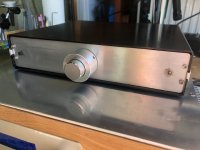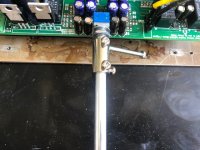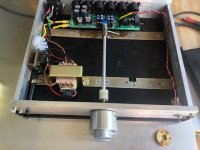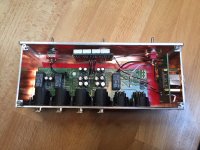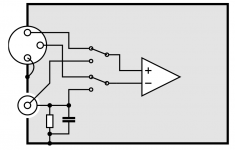Davide, Great job with the Re-use!
The big question is: How does it sound?
John
Sounds very good, very silent.
This is my final simple mechanical implementation. The max gain is set to 0db.
D.
Attachments
Two questions: did someone heard/measured and difference between the 7812 regulators and the hypex?
What is a source of the hypex regulators that does not charge 70 euros for shipment in Europe?
Regards,
Davide
What is a source of the hypex regulators that does not charge 70 euros for shipment in Europe?
Regards,
Davide
So, I have my 64-step VolCB assembled and ready to test. However, I forgot to pickup a rotary encoder. What would be a good encoder for this? I plan to start with Alex's Arduino sketch. Thanks.
Hi Davide, I got mine from DIYclassd.com, which is Hypex’s own webshop. Not sure anymore what shipping cost exactly, but I am sure that it was a lot less than €70!
DIYclassd's shipping costs are weird. If you ship within the Netherlands, it is €8.70 - expensive, but not overly so. If you ship to the U.S., it is €38. Ok, this is crossing the ocean, so it is not unreasonable. If you ship to Austria, is an astonishing €63. Since a pair of HxR12 is just €30, it makes no sense to pay that much for shipping.
I would just use 7812/7912 until a better opportunity arises. Not too difficult to desolder those 3-pin TO220's if need be.
Otherwise, you may consider +/-15V shunt regulators from tentlabsshop.com - they are more than twice as expensive, but the shop only charges €13 for shipping, so the total is (a little bit) less. Note they are much taller, too. Not sure how relays will work at 15V though.
Another alternative is to use offboard regulators. It is not as elegant, but since you need to place the transformer somewhere, why not place your power supply in the same place? You can consider, for example, Walt Jung's universal shunt regulator boards I offer, or the Super Reg boards (same thing but series, not shunt) here in the diyAudio Store, or even Ti's TPS7A3001/TPS7A4901 evaluation module (TPS7A30-49EVM-567) - it is only $20 for two rails. You will need to change two resistors to get +/-12V in the EVM.
I would just use 7812/7912 until a better opportunity arises. Not too difficult to desolder those 3-pin TO220's if need be.
Otherwise, you may consider +/-15V shunt regulators from tentlabsshop.com - they are more than twice as expensive, but the shop only charges €13 for shipping, so the total is (a little bit) less. Note they are much taller, too. Not sure how relays will work at 15V though.
Another alternative is to use offboard regulators. It is not as elegant, but since you need to place the transformer somewhere, why not place your power supply in the same place? You can consider, for example, Walt Jung's universal shunt regulator boards I offer, or the Super Reg boards (same thing but series, not shunt) here in the diyAudio Store, or even Ti's TPS7A3001/TPS7A4901 evaluation module (TPS7A30-49EVM-567) - it is only $20 for two rails. You will need to change two resistors to get +/-12V in the EVM.
Last edited:
Jung Super Reg vs. hypex Regs
I have both Hypex regs being discussed here as well as the Walt Jung Super Reg shunts from Sjostrom audio.
Likely tough to tell the difference in either case but given the choice of the two which would be best ?
Not in terms of convenience of implementation but quality of regulation for this particular use case?
I have both Hypex regs being discussed here as well as the Walt Jung Super Reg shunts from Sjostrom audio.
Likely tough to tell the difference in either case but given the choice of the two which would be best ?
Not in terms of convenience of implementation but quality of regulation for this particular use case?
What would be the proper way of connecting RCA jacks to the inputs, since my sources are all unbalanced at this point?
I'm frequently questioned concerning the IM23TS relay that I used for the volume control boards.
These relays were long time out of stock, but momentarily Farnell has a few thousands of them.
But in case using another relay, be aware that the PCF8574AT driver can only sink 80mA.
So with 6 relays, that's a max of 13mA per relay.
However the pin replaceable PCA8574AD can sink 200mA or 33mA per relay giving you more options for a relay selection.
Hans
These relays were long time out of stock, but momentarily Farnell has a few thousands of them.
But in case using another relay, be aware that the PCF8574AT driver can only sink 80mA.
So with 6 relays, that's a max of 13mA per relay.
However the pin replaceable PCA8574AD can sink 200mA or 33mA per relay giving you more options for a relay selection.
Hans
Since the Maya solution with VolCB is no longer available, and Arduino solutions are coming up, I could provide this PCB if there is still demand for.
Hans
Hans
What would be the proper way of connecting RCA jacks to the inputs, since my sources are all unbalanced at this point?
Cables or adapters.
D
Seems both the PCA8574AD driver IC and the IM23TS relays are not stocked anywhere in the US. Are there any workable substitutes for these?
Seems both the PCA8574AD driver IC and the IM23TS relays are not stocked anywhere in the US. Are there any workable substitutes for these?
Newark US has 2109 IM23TS in stock !!
Hans
Yes, Newark UK shows them in stock but not in the USA. I ordered some from the UK site. They say 5 to 7 days shipping.
Thanks Hans for the info.
Thanks Hans for the info.
Nikon 1975 wrote
>> Cables or adapters
However, let's say I want to put female RCA jack on the preamp chassis. How do I wire the RCA jack to one of the BAL inputs?
>> Cables or adapters
However, let's say I want to put female RCA jack on the preamp chassis. How do I wire the RCA jack to one of the BAL inputs?
Nikon 1975 wrote
>> Cables or adapters
However, let's say I want to put female RCA jack on the preamp chassis. How do I wire the RCA jack to one of the BAL inputs?
This maybe helpful.
https://www.diyclassd.com/img/upload/doc/an_wp/AN_Legacy_pin_1_problems.pdf
- Home
- Source & Line
- Analog Line Level
- BPPBP - Bruno Putzey's Purist Balanced Preamp (well a balanced volume control really)
